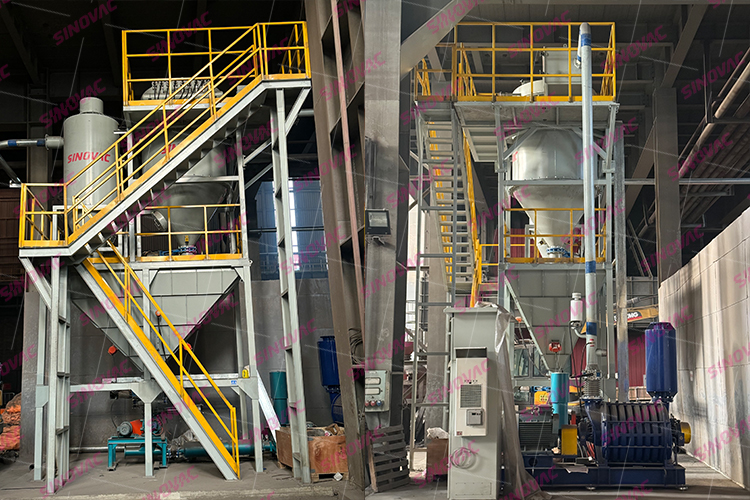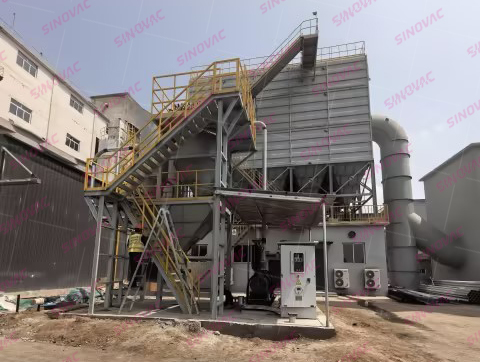INFORMATION CENTER
Application Effects of Negative Pressure Cleaning System in Foundries
The system significantly improves dust removal efficiency: the capture rate in high-dust areas exceeds 95%, reducing the dust concentration in the working environment from 8-12mg/m³ to ≤2mg/m³, which meets occupational health standards.
For equipment and pipelines, wear-resistant materials (e.g., 304 stainless steel and ceramic composite pipes) are adopted, reducing the wear rate by 70% and extending the service life to 5-6 years. The anti-clogging design lowers the clogging rate from 15%-20% to ≤3%, reducing monthly maintenance man-hours.
In terms of safety, explosion-proof vacuum pumps, explosion vents, and pipeline flame arresters fully prevent and control the risk of dust explosions. In high-temperature areas, water-cooled jackets reduce the temperature of residual sand from 200℃ to ≤100℃, avoiding filter bag damage. The system adopts interlocking control with processing equipment, reducing manual operations and the risk of pneumoconiosis.
The emission concentration is ≤8mg/m³, which is better than national standards. Moreover, the cyclone separator recovers over 85% of coarse sand, saving 10,000-20,000 yuan in sand material costs per month.
Additionally, the system indirectly improves production efficiency: it reduces the frequency of manual dust cleaning, enhances workshop visibility, and increases the average daily efficiency of the production line by 5%-8%.
Targeting the characteristics of foundries—heavy dust, high abrasion, and significant risks—the negative pressure cleaning systemachieves multi-dimensional benefits in practical application through precise capture and scientific design. The specific effects are as follows:

Application Effects of Negative Pressure Cleaning System in Foundries
1. Significantly Improved Dust Control Efficiency, Optimizing the Working Environment
Capture rate in high-dust areas exceeds 95%: For core dust-generating equipment such as sand drop machines and shot blasting machines, the annular enclosed suction hoods and fully sealed adaptive design can efficiently capture molding sand dust and metal debris. For example, for a sand drop machine processing 50 tons of molding sand per hour, after the system treatment, the dust concentration within 10 meters around the machine is reduced from 8-12mg/m³ (before treatment) to ≤2mg/m³, which fully meets the limit requirement for silica dust specified in Occupational Exposure Limits for Harmful Factors in the Workplace (GBZ2.1).
No residue of fine powder and residual sand: For manual grinding tables, the matching of strip-shaped suction hoods (suction inlets are ≤300mm away from the grinding surface) and an air volume of 1500-2000m³/h enables a fine powder capture rate of over 98%, preventing dust accumulation in equipment gaps or on the ground. In the pouring area, high-temperature-resistant telescopic suction arms can flexibly clean residual sand, reducing secondary dust emission caused by scattered residual sand.
2. Enhanced Durability of Equipment and Pipes, Reducing Maintenance Costs
Outstanding wear resistance: The combination of 304 stainless steel (wall thickness ≥3mm) for main pipes and wear-resistant ceramic composite pipes for branch pipes reduces the pipe wear rate by 70% compared with ordinary carbon steel pipes during long-term use (average daily operation of 8 hours) in sand processing workshops. The service life is extended from 1-2 years to 5-6 years. For bag filters, Nomex wear-resistant filter cloth is adopted, extending the filter bag replacement cycle from 3-4 months to 10-12 months.

Strengthened anti-clogging capability: The pipe design with a slope of ≥3°, large-curvature bends (R≥3D), and the installation of pneumatic impact valves every 50 meters can effectively prevent molding sand dust deposition and clogging. The system clogging rate is reduced from 15%-20% (with traditional cleaning methods) to ≤3%, reducing downtime caused by pipe dredging (saving 4-6 hours of maintenance man-hours per month).
3. Effective Prevention and Control of Safety Risks, Ensuring Stable Production
Comprehensive explosion-proof and high-temperature-resistant protection: The combination of explosion-proof Roots vacuum pumps (Ex dⅡCT4 rating), explosion-proof diaphragms for dust collectors (bursting pressure of 0.15MPa), and pipeline flame arresters can completely block dust explosion risks. No safety accidents caused by static electricity or combustible dust have occurred in application. The water-cooled jackets for pipes in the pouring area can cool high-temperature residual sand from 200℃ to ≤100℃, avoiding high-temperature damage to filter bags, and reducing the probability of filter bag failure due to high temperature to 0.
Safer equipment interconnection: The system adopts interlocking control with processing equipment (the cleaning system starts synchronously with the processing equipment and shuts down 30 seconds after the equipment stops). This not only ensures timely dust cleaning but also avoids energy waste caused by equipment no-load operation. Meanwhile, it reduces the frequency of manual operation (which involves dust exposure) for personnel, lowering the risk of pneumoconiosis.
4. Win-Win Outcome of Environmental Compliance and Resource Recovery
Easy compliance with emission standards: After two-stage purification by "cyclone separator + bag filter", the dust emission concentration of the exhaust stack is ≤8mg/m³ (far lower than the requirement of ≤30mg/m³ in GB16297 National Emission Standard for Air Pollutants). In addition, the height of the exhaust stack is ≥15m, meeting the monitoring standards of environmental protection authorities and eliminating the risk of environmental penalties.
Dust recovery and reutilization: The recovery rate of coarse molding sand (particle size ≥200μm) separated by the cyclone separator exceeds 85%, which can be reused in the core-making process. This saves medium-sized foundries 10,000-20,000 yuan in molding sand procurement costs per month. Collected metal debris can be handed over to professional institutions for recycling, realizing "turning waste into treasure".

5. Indirect Improvement of Production Efficiency
The system eliminates the need for frequent manual dust cleaning, reducing equipment downtime caused by manual cleaning (e.g., the cleaning interval for shot blasting machines is extended from once a day to once every three days). At the same time, clear visibility in the workshop facilitates equipment fault diagnosis, indirectly improving the average daily operation efficiency of foundry production lines by 5%-8%.
Application Effects of Negative Pressure Cleaning System in Foundries
Contact Us
—
Address: 608, block a, National Convention and Exhibition Center, No. 1998, Zhuguang Road, Qingpu District, Shanghai
Tel: 15121023409 Manager Wang

We provide OEM production for more customers who really understand vacuum cleaning system.
© Shanghai Wellson Environmental Technology Co., Ltd.